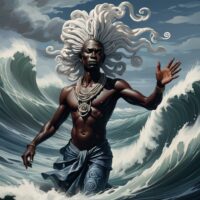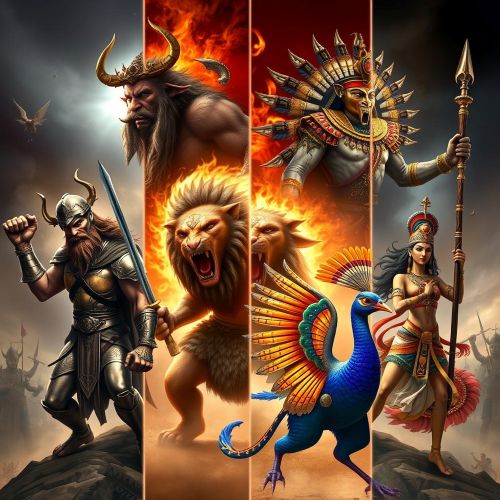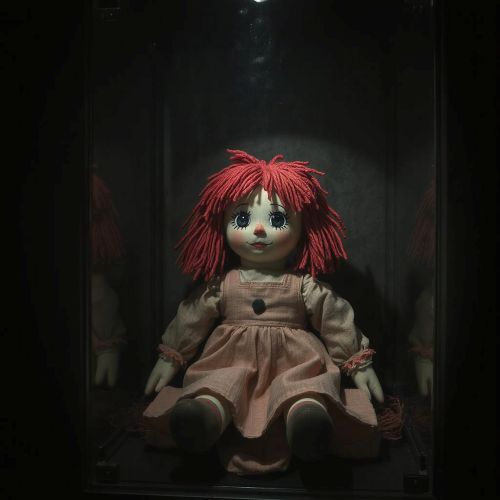Kalunga : God of the Sea
Listen
At a glance
| Description | |
|---|---|
| Origin | Chokwe Mythology |
| Classification | Gods |
| Family Members | N/A |
| Region | Democratic Republic of the Congo, Angola, and Zambia |
| Associated With | Oceans, Water |
Kalunga
Introduction
Kalunga is a central figure in Chokwe mythology, which originates from the Chokwe people primarily located in Angola, the Democratic Republic of the Congo, and Zambia. This deity embodies both the boundary between life and death and the vast, often dangerous waters. Kalunga is integral to the Chokwe cosmology, representing their beliefs about the afterlife and the spiritual world. Among the many deities in Chokwe mythology, Kalunga stands out as the god of the sea, with his power intricately linked to the vital element of water.
Physical Traits
Kalunga, a significant figure in Chokwe mythology, is not typically described with a specific physical form. Instead, Kalunga symbolizes the ocean or a vast body of water, emphasizing an encompassing, omnipresent force rather than a deity with human-like attributes. This lack of a distinct anthropomorphic form underscores Kalunga’s nature as the boundary between the physical and spiritual realms. In some interpretations, Kalunga is visualized as an endless expanse of water, reflecting this role.
Revered by the Chokwe people, Kalunga is seen as a powerful presence residing in the ocean’s unfathomable depths. This absence of a concrete image allows for a deeper connection, with Kalunga embodying the vastness and power of the sea itself. While some interpretations depict Kalunga as a humanoid figure merging with the ocean, such as with flowing white hair mimicking the ocean’s churning whitecaps or a glistening, fish-like tail representing dominion over aquatic creatures, these depictions are secondary to the awe-inspiring vastness Kalunga represents.
Family
Kalunga exists within a complex web of Chokwe deities. While specific details about his family lineage are scarce, some narratives position him as a primordial being, existing before creation itself and possibly the source from which all water sprang, birthing the world and its inhabitants. Kalunga stands alongside other Chokwe deities such as Nzambi Mpungu (the supreme being), Cihongo (the spirit of wealth and prosperity), and Pwo (the embodiment of feminine beauty and fertility). These divine figures form a pantheon that shapes Chokwe cosmology and daily life.
Other stories suggest a connection to Nyaminyambi, the earth goddess. Their union, it is believed, gave rise to all living things, signifying the vital link between fertile land and life-giving water. This interconnectedness forms the bedrock of Chokwe belief systems, emphasizing the delicate balance between humanity and the natural world.
Kalunga’s role in Chokwe mythology is more conceptual than familial. Unlike many mythological beings in various cultures who are part of extensive divine genealogies, Kalunga stands as a singular, almost elemental force. In the broader context of Chokwe spirituality, Kalunga is part of a larger cosmological framework that includes various spirits and ancestors. These spirits, known as “mizimu,” interact with Kalunga as they transition from the world of the living to the spiritual realm.
Other names
Kalunga, a central figure in Chokwe mythology, is known by various names and titles that reflect different aspects of his domain and influence. His primary name resonates with the power of the ocean, while variations like “Kalunga wa Ndondo” (Kalunga of the Deep) or “Kalunga wa Nzazi” (Kalunga of the Ocean) highlight specific facets of his realm. These variations may differ across Chokwe communities or oral traditions, showcasing Kalunga’s widespread recognition among neighboring ethnic groups, who may revere similar sea deities under different names.
In addition to his primary names, Kalunga is referred to with epithets that underscore his power and benevolence. Titles such as “Mwami wa Mpungu” (King of Rain) or “Nganga a Nzazi” (Healer of the Ocean) exemplify his influence over the elements and his role in bringing life and health to the Chokwe people. This diversity of names and titles associated with Kalunga highlights his multifaceted nature and the various ways he is revered within Chokwe culture.
Powers and Abilities
Kalunga, a deity central to Chokwe mythology, holds vast powers that reflect his pivotal role as the guardian of the boundary between life and death. As the embodiment of the ocean, Kalunga commands water’s influence over both the physical and spiritual realms. He guides souls to the afterlife, bridging the gap between the living and the deceased—a crucial function in Chokwe rituals and beliefs concerning death and the afterlife. Kalunga also possesses protective abilities, safeguarding communities and their resources, particularly crucial in a culture where agricultural prosperity and livestock welfare are paramount. This reverence for Kalunga underscores the deep interconnection between spiritual beliefs and everyday life in Chokwe society.
Kalunga’s domain extends beyond mere symbolism; he wields the unpredictable power of the sea itself. As the ultimate authority over water, he bestows prosperity through rain, vital for bountiful harvests and community well-being. Additionally, Kalunga is revered for his healing abilities, believed to reside within the ocean’s depths. However, his wrath can be swift and devastating, manifesting in storms and floods when nature’s delicate balance is disrupted or his authority disregarded. This dual nature—provider and destroyer—mirrors the inherent power and capriciousness of the ocean.
Furthermore, Kalunga’s influence encompasses rivers and lakes, ensuring abundant harvests and sustaining Chokwe communities with plentiful fish. Ritual offerings are regularly made to Kalunga to secure continued blessings and protection against natural disasters such as floods and storms. His association with water extends beyond mere sustenance to embody renewal, growth, and the cyclical nature of life itself, reinforcing his role in nurturing vitality within the Chokwe worldview.
Modern Day Influence
Kalunga’s influence persists prominently in Chokwe culture today. Traditional Chokwe art frequently depicts symbolic representations of the ocean, embodying reverence for Kalunga. Offerings are regularly made to him, particularly by fishermen seeking safe journeys and plentiful catches. However, perhaps the most profound aspect of Kalunga’s enduring legacy lies in the environmental message inherent in the myths. The Chokwe people recognize the delicate balance between humanity and the natural world, with Kalunga’s power serving as a constant reminder to respect the ocean and its resources.
In contemporary times, Kalunga remains a vital cultural symbol for the Chokwe people. His mythology and beliefs continue to shape traditional practices, ceremonies, and community values. Rituals honoring Kalunga persist, especially those associated with funerals and ancestor veneration, underscoring his ongoing role in guiding departed souls and protecting the living. Moreover, Kalunga continues to inspire modern artistic expressions, spanning literature, music, and visual arts. Artists and writers draw on Kalunga’s rich symbolism to explore themes of life, death, and humanity’s relationship with the natural and spiritual realms.
This enduring cultural presence ensures Kalunga’s legacy adapts to contemporary contexts while preserving its essence. Beyond the Chokwe community, Kalunga’s symbolism informs broader discussions about African spirituality and mythology. Scholars and cultural enthusiasts study Kalunga to deepen their understanding of the Chokwe worldview and the intricate dynamics between mythology, culture, and identity in African societies. Through academic research and cultural preservation efforts, Kalunga’s narrative continues to be shared and celebrated, enriching global appreciation of Chokwe heritage.
Related Images
Frequently Asked Questions
What is lorem Ipsum?
I am text block. Click edit button to change this text. Lorem ipsum dolor sit amet, consectetur adipiscing elit. Ut elit tellus, luctus nec ullamcorper mattis, pulvinar dapibus leo.
What is lorem Ipsum?
I am text block. Click edit button to change this text. Lorem ipsum dolor sit amet, consectetur adipiscing elit. Ut elit tellus, luctus nec ullamcorper mattis, pulvinar dapibus leo.
What is lorem Ipsum?
I am text block. Click edit button to change this text. Lorem ipsum dolor sit amet, consectetur adipiscing elit. Ut elit tellus, luctus nec ullamcorper mattis, pulvinar dapibus leo.
What is lorem Ipsum?
I am text block. Click edit button to change this text. Lorem ipsum dolor sit amet, consectetur adipiscing elit. Ut elit tellus, luctus nec ullamcorper mattis, pulvinar dapibus leo.
What is lorem Ipsum?
I am text block. Click edit button to change this text. Lorem ipsum dolor sit amet, consectetur adipiscing elit. Ut elit tellus, luctus nec ullamcorper mattis, pulvinar dapibus leo.





